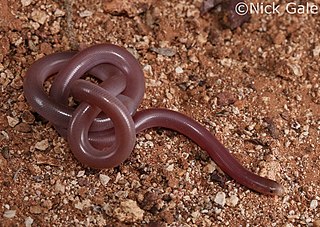
The Typhlopidae are a family of blind snakes. They are found mostly in the tropical regions of Africa, Asia, the Americas, and all mainland Australia and various islands. The rostral scale overhangs the mouth to form a shovel-like burrowing structure. They live underground in burrows, and since they have no use for vision, their eyes are mostly vestigial. They have light-detecting black eye spots, and teeth occur in the upper jaw. Typhlopids do not have dislocatable lower jaw articulations restricting them to prey smaller than their oral aperture. All species in the family Typhlopidae are fossorial and feed on social fossorial invertebrates such as termites and ants. The tracheal lung is present and chambered in all species. One species, the Brahminy's blind snake, is the only unisexual snake, with the entire population being female and reproducing via parthenogenesis. The tail ends with a horn-like scale. Most of these species are oviparous. Currently, 18 genera are recognized containing over 200 species.

Amerotyphlops brongersmianus, known commonly as Brongersma's worm snake or the South American striped blindsnake, is a species of harmless blind snake in the family Typhlopidae. The species is native to South America and Trinidad and Tobago in the Caribbean. No subspecies are currently recognized.

Atractaspis bibronii is a species of venomous snake in the family Atractaspididae. The species is endemic to Africa. There are no subspecies that are recognised as being valid. Its common names are the Southern stiletto snake, Bibron's stiletto snake, Side-stabbing snake; previously it was known as Bibron's burrowing asp, Bibron's mole viper, and the mole adder.
Letheobia simonii is a blind snake species endemic to the Middle East. No subspecies are currently recognized.
The Cameroon racer, Poecilopholis cameronensis, is a species of rear-fanged mildly venomous snake endemic to Africa. Poecilopholis is a monotypic genus created for this species.
Aparallactus lineatus, or the lined centipede-eater, is a species of mildly venomous rear-fanged snake in the family Atractaspididae.
Polemon gracilis, or the graceful snake-eater, is a species of mildly venomous rear-fanged snake in the family Atractaspididae. It is endemic to Africa.

Leptotyphlops nigricans, also known as the black threadsnake or black worm snake, is a species of snake in the family Leptotyphlopidae. It is endemic to Africa.

Anilios endoterus is commonly known as the interior blind snake. It is one of 42 species of snake in the genus Anilios (Ramphotyphlops) from the Typhlopidae family living in Australia. These snakes appear to be blind, having vestigial eyes that are extremely sensitive to light. It is a cryptic burrowing snake that lives in tunnels underground, living mainly on a diet of ants. They are found in arid and semi-arid desert regions of central Australia and are considered endangered in New South Wales (NSW).

Rhinotyphlops schinzi, commonly known as Schinz's beaked blind snake, is a species of snake in the family Typhlopidae. The species is endemic to southern Africa.
Letheobia somalica, also known as the highland beaked snake or Ethiopian blind snake, is a species of snake in the family Typhlopidae. It is endemic to Ethiopia.
Rhinotyphlops unitaeniatus, commonly known as the yellow-striped blind snake or the Kenya beaked snake, is a species of snake in the Typhlopidae family. It is endemic to Africa.
The Bahamian slender blind snake is a species of snake in the family Typhlopidae.
Fornasini's blind snake is a species of snake in the family Typhlopidae. The species is endemic to southern Africa.
Gierra's blind snake, also commonly called the Usambara spotted blind snake and the Usambara spotted worm snake, is a species of snake in the family Typhlopidae. The species is endemic to Tanzania.
Afrotyphlops obtusus, also known as the slender blind snake or southern gracile blind-snake, is a species of snake in the Typhlopidae family. It is endemic to East Africa.
Steinhaus's worm snake is a species of snake in the family Typhlopidae. The species is endemic to Central Africa.

Afrotyphlops schlegelii, commonly known as Schlegel's beaked blind snake or Schlegel's giant blind snake, is a species of snake in the family Typhlopidae. The species is endemic to eastern and southern Africa, and bears the distinction of being the world's largest typhlopid. It is harmless to humans and lives exclusively on a diet of termites.

Afrotyphlops is a genus of snakes in the family Typhlopidae.
Afrotyphlops blanfordii, or Blanford's blind-snake, is a species of snake in the family Typhlopidae. The species is native to the Horn of Africa.









